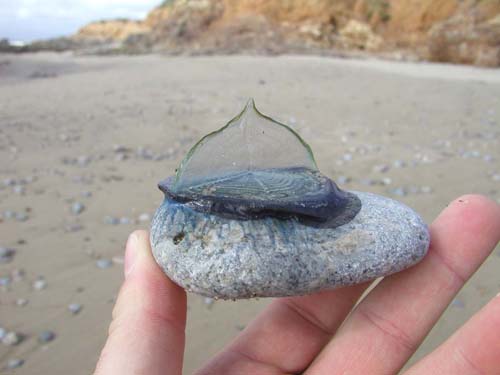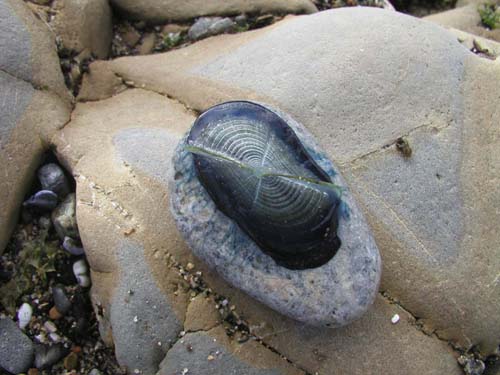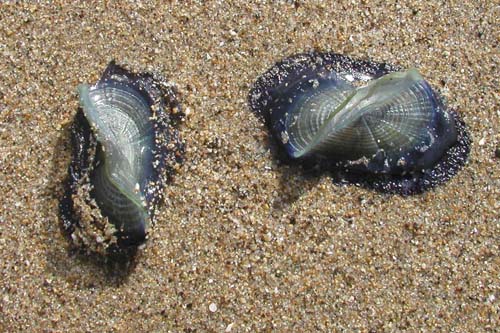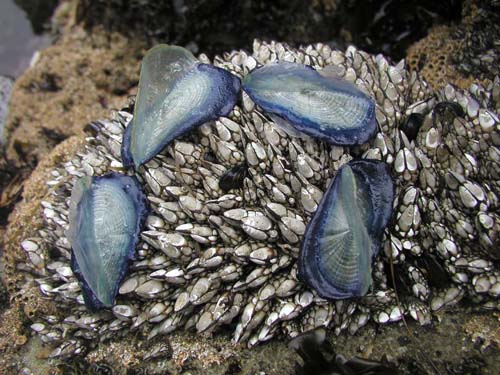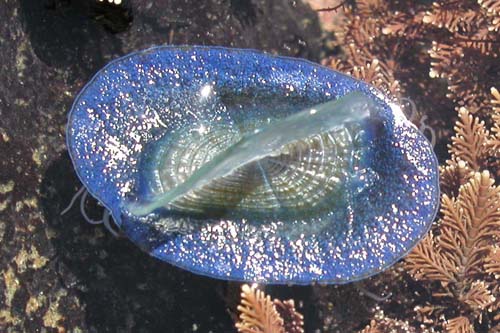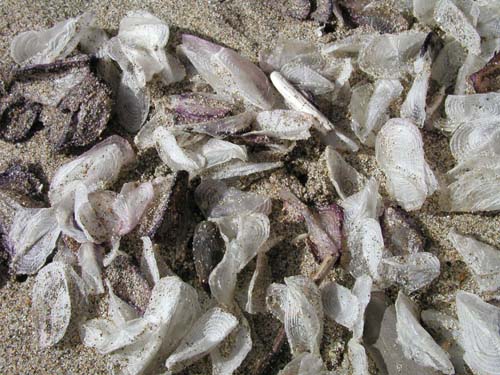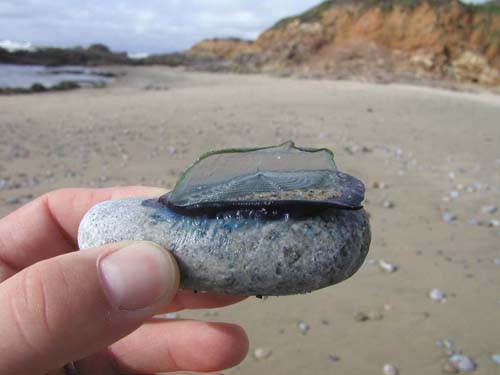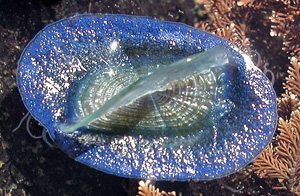
By-the-Wind Sailor
Velella velella
Overview
Key Features:
Blue body is disc shaped, with clear tentacles hanging down and a central clear sail in the middle of the disc.
Primary Common Name:
By-the-Wind SailorGeneral Grouping:
JelliesGeographic Range:
Washington to Mexico
Velella velella has a cosmopolitan distribution, usually in warm to warm-temperate waters. On the Atlantic coast of North America, they can be found as far north as Cape Hatteras, or occasionally further, and on the Pacific coast they can found as far north as Washington.
Intertidal Height:
0 to 0 feet (0 to 0 meters)Notes:
They can wash ashore to the intertidal and coat large areas as they perish in the sun.
Subtidal Depth Range:
Minimum Depth: 0 meters or 0 feetMaximum Depth: 0 meters or 0 feet
Notes:
They float at the surface of the ocean.
Habitats:
bay (rocky shore), bay (sandy shore), exposed rocky shore, exposed sandy beaches, pelagic zone, protected rocky shore, protected sandy beachesNotes:
Velella velella occupies the ocean's surface.
Abundance:
Relative Abundance:
Velella velella is seasonally abundant and is commonly seen washed up on beaches during the spring and summer.
Species Description:
General:
Velella velella is commonly seen littered all across beaches along the west coast during the late spring and early summer. During this time of year, they live at the ocean's surface and especially strong winds can cast millions of them ashore. Velella velella belongs to the Class Hydrozoa in the Phylum Cnidaria. Older zoological opinions considered this organism to be a colony of specialized individuals, like the Portuguese man-of-war, Physalia physalis. However, Velella velella is actually considered a single elaborate polyp floating upside down with its mouths and tentacles dangling into the water, although it has also been interpreted as a floating hydroid colony with a single, central feeding polyp surrounded by reproductive polyps with mouths. Velella velella is accurately called a chondrophore, being in the order Chondrophora, whereas the term siphonophore, in the Order Siphonophora, is used for such colonial creatures such as Physalia physalis. The order Chondrophora is small, with only a single family, Porpitidae, two genera and six species including Velella velella.
Distinctive Features:
The float of Velella velella consists of a flat, oval, cartilage-like skeleton full of gas-filled pockets which serve as a float. The vertical, cantilevered triangular crest is a chitinous sheet that is set diagonally across the top, serving as a sail. Velella velella is deep-blue colored and transparent. It has a single large-mouthed feeding tube, surrounded by rows of reproductive bodies. There are many blue stinging tentacles around the rim, these tentacles are harmless to humans.
Size:
The float of Velella velella can grow to be 102 mm long, 76 mm wide and 51 mm high.
Natural History:
General:
Velella velella is incredibly stabile and seaworthy by design. The sail is triangular, slightly thicker at its base, stiffened by superficial thickened ridges, and yet still quite flexible. This incredible design allows smooth bending when its sail is under load, recoiling when the wind lets up, and overall minimizes the risk of kinking. The whole animal tilts when under sail, hull broadside to the flow of oncoming water.
Velella velella drifts before the wind, almost always tacking about 45 degrees to the right of the prevailing northwesterlies. This is normally enough to keep them offshore, however southerly or extremely strong onshore winds can cause them to spin around and follow the wind at a much closer angle that brings them toward land. Once washed ashore, the animals die and disintegrate within a few days.
Amazingly, the set of the sails of animals off the coast of temperate Asia mirrors that of our Velellas, so that the northwesterlies, which prevail there as well, blow the animals to the left and so keep them at sea as effectively as the winds do here. And in the southern hemisphere, the distribution of the two forms of Velella velella are reversed tacking 45 degrees to the left of prevailing winds instead of the right.
Velella velella's color is a result from the ingested prey's carotenoid pigments, which are modified to become blue and serve to screen excess light in the bright ocean surface world. They spend several months at the sea surface during spring plankton blooms and during this time, the animals sail in the wind feeding while their symbionts photosynthesize in the sun.
Predator(s):
Velella velella is eaten by many surface-dwelling animals.
Prey:
Velella velella feeds on fish eggs, euphausiid eggs, copepods, larvaceans and crustacean larvae.
Feeding Behavior:
CarnivoreNotes:
Velella velella feeds on relatively passive prey. This animal also harbors symbiotic single-celled algae, zooxanthellae, which through photosynthesis, contribute to its nutrition. It is a suspension feeder, but not sessile since it floats through the water.
Seasonal Behavior
Reproduction:
When reproductive, Velella velella buds off tiny medusae from small stalked mouths beneath its float that surround the polyp's larger central mouth. The medusae, like the adult polyps, bear zooxanthellae. Medusae will develop into maturity without feeding, and therefore must derive nutrition from their zooxanthellae. They descend to depths of 600 – 1000 m and then female medusae each produce one relatively large 0.5 mm orange egg and when combined with male medusae sperm, a tiny orange planula larva results. The planulae, later develop into conaria, the next larval stage. The medusa and conaria stages have only been found in the Mediterranean and North Sea. During its one to four months of wintertime residence at depth, the conaria enters still another larval stage, during which it develops a rudimentary sail and floats, secretes a drop of oil, becomes buoyant, and by spring ascends to the sea's surface. During the spring and summer, the animals feed at the surface and the life cycle is repeated with another brood produced synchronously to ascend with the fall plankton bloom. Velella velella from the fall brood are much smaller than those in the spring and this is likely due to the smaller fall plankton bloom. This reproductive cycle is carefully tuned to prevent undue dispersal of the animals while at depth and ensure that they will be able to take advantage of favorable sea surface conditions.References
- Alden, P., F. Heath, R. Keen, A. Leventer, and W. Zomlefer. 2002. National Audubon Society Field Guide to California. A.A. Knopf, New York, NY.
- Banaszak, A.T., R. Iglesias-Prieto, and R.K. Trench. 1993. Scrippsiella velellae, sp. nov. (Peridiniales), and Gloeodinium viscum, sp. nov. (Phytodiniales): Dinoflagellate symbionts of two hydrozoans (Cnidaria). Journal of Phycology 29 (4): 517 – 528.
- Bieri, R. 1977. The ecological significance of seasonal occurrence and growth rate of Velella (Hydrozoa). Publications of the Seto Marine Biological Laboratory 24 (1/3): 63 – 76.
- Langstroth, L. and L. Langstroth. 2000. A Living Bay: The Underwater World of Monterey Bay. University of California Press, Berkeley and Los Angeles, CA. 287 p.
- Larson, R.J. 1980. The medusa of Velella velella (Linnaeus, 1758) (Hydrozoa: Chondrophorae). Journal of Plankton Research 2 (3): 183 – 186.
- Meinkoth, N.A. 1998. National Audubon Society Field Guide to North American Seashore Creatures. A.A. Knopf, New York, NY. 813 p.
- Ricketts, E. F., J. Calvin, and J.W. Hedgpeth. 1985. Between Pacific tides. Stanford University Press, Stanford, CA. 652 p.
- Wrobel, D. and C. Mills. 1998. Pacific Coast Pelagic Invertebrates: a guide to the common gelatinous animals. Monterey, California, Sea Challengers, Monterey Bay Aquarium. 108 p.
Related Information
Photo Library
Click on an image below to view a larger version in the SIMoN Photo Library. You will also be able to view important information on each photo such as photographer, date, caption and more
